From the outside, late on a Tuesday night, the downstairs of Whitlow’s DC looks like any other restaurant in town: fairly empty and quiet. Step inside, though, and you’ll hear the magic coming from above. This isn’t a speakeasy — it’s something much better.
Welcome to the Sonic Lifeline’s Jam Session at Whitlow’s DC, tucked discreetly into a second-floor space on the busy corner at 9th and U Streets NW.
Once you walk upstairs, you enter a much different space than what greets you on the ground floor. The music and crowd are vibrant and energetic, with colorful LED’s illuminating the stage area to help set the vibe. What’s in store for the next couple of hours will be one of the most fun, dynamic performances you can see around the nation’s capital these days.
Though the session is hosted and expertly handled by drummer Jo Palmer, the event is organized by the Sonic Lifeline, a still-young organization that curates jazz performances between D.C. and Baltimore. The Sonic Lifeline’s founders, photographer Nick Moreland and his uncle Ed Baldi, decided to start the organization during the early days of the COVID-19 pandemic, after thinking about music’s ability to heal and bring people together during difficult times. “It was a very personal lifeline of taking our love of music, and it really was a way to continue,” Baldi said of the organization’s founding. “A lifeline for the community, and a lifeline for the artists.”
More than just their love for music, Moreland and Baldi bring their expertise from working in the arts space. Moreland, a D.C. native, has long been deeply ingrained within the local music scene as a photographer, shooting performances and album covers for local artists. Baldi, who resides in Baltimore, is a seasoned live show producer and an artist himself. The two combine their passion, experience and connections to form partnerships with venues to curate live shows that stand out from all others in the area.
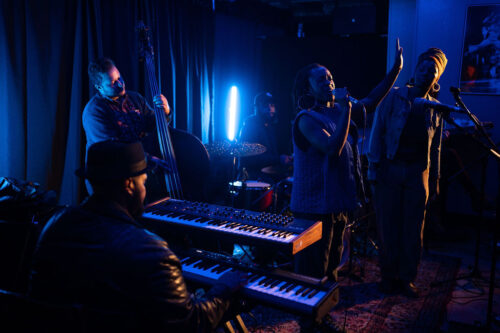
It’s still a young organization, only in its second year of operation, but the Sonic Lifeline already has a number of established series around town and is making its impact felt on the scene. There’s the aforementioned Jam Session at Whitlow’s, as well as monthly performances at the Hemingway Room at Little Havana in Baltimore. Then there are the special events they host with Treehouse, an off-the-beaten-path, community-oriented venue in uptown D.C.
Part of what distinguishes the Sonic Lifeline from other presenting organizations run by non-musicians is that for them, the artists come first. They guarantee a set fee for performers and create a space where they feel comfortable fully expressing themselves. The artists can perform without restraints, and the audience is able to bear witness to some of the purest performances in town. Both Moreland and Baldi mentioned how jazz musicians are sometimes only hired to provide ambiance for a space, especially in restaurant and bar settings. This is particularly true for venues where musicians must compete with whatever game is on a bar’s TV, they noted.
”We’re doing this in a way that the artists are the stars,” Baldi said. “Any bar or restaurant owner can hire an artist. And they should. The more places people can play, the better. But what Nick and I try to do is to create a new space.” At a Sonic Lifeline event, all eyes and ears are on the musicians who’ve come to perform — not to provide a soundtrack for March Madness.
‘I’ve seen people leave in groups. I’ve seen friendships get made. . . . I appreciate being a part of helping to foster a space for artists to meet.’
— Jo Palmer, drummer
Artists are free to play what they want to and don’t have to stick to a strict list of popular songs. If they want to play a deep cut, an original piece, or something more experimental, it’s welcomed. This is by design, Baldi explained. When artists are in a space where they feel free and comfortable, “the performance is going to be elevated in a way that the audience is privileged to peer into this world,” he said. “The audience walks away seeing something that is special and can’t just be repeated.”
The Jam Sessions at Whitlow’s DC are just that: musicians jamming out, using jazz as a foundation but flowing in and out of different genres. To call the performance dynamic might be an understatement.
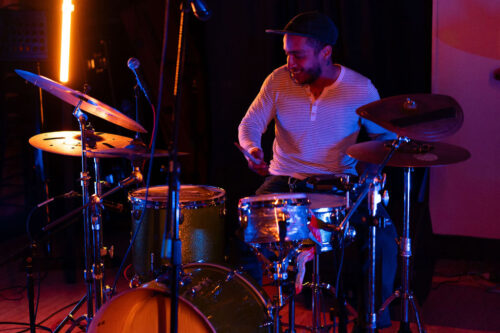
Tuesday nights almost always begin with a set from Palmer and the rest of the house band, followed by an intermission set by DJ Exaktly. Though the house band’s set is always electric, the last half of the show is where the music tends to push to new heights. Palmer opens up the session for other artists to start filling in, and the show evolves from there. This is where you start to realize that the person you have been standing next to at the bar might be an acclaimed jazz singer, or maybe a music student at Howard. At this point, band members will switch out, additional musicians will join, vocalists will hop in, some people might even start a dance routine.
This is not the typical straight-ahead session you might find elsewhere in D.C. Palmer said that he likes the sessions to be “very freeform and inclusive.” He’s into “into just letting the concept of jamming be a thing,” he explained. “We do play songs, but it’s heavily based on who’s in the room, and the vibe.” Each Jam Session is unique and unpredictable.
One of the things that makes the Whitlow’s Jam Session – and the Sonic Lifeline’s shows in general – special is its intentionality in bridging gaps within the music scene. This is a key reason why Palmer was tapped to lead the Jam Sessions. “Jo is someone who I thought could be a trailblazer for a new session — for a new community-based event on U Street that’s tapping into a lot of things that have been lost in that area of the city,” Moreland said.
Palmer sees this bridge being built at every Tuesday-night session, without regard to age or genre. “Some cats got together and had a [recording] session,” Palmer recalled. “I think they have a project or a band that’s getting started, but they all met at the session. I’ve seen that happen a few times. I’ve seen people leave in groups. I’ve seen friendships get made. And that’s cool. I appreciate being a part of helping to foster a space for artists to meet.”
While the Whitlow’s session is a home for experimentation, the Hemingway Room provides artists an opportunity to display their honed craft. Located in the back room of Baltimore’s Little Havana restaurant, the Sonic Lifeline’s Hemingway Room series was originally founded as a way for Baldi, who lives nearby, to curate a musical space for his neighbors. Baldi recalled asking himself: “What can I do to get involved and try and build community?”
The Hemingway Room differs from the Jam Session in that it is formatted as more of a traditional show — so, no spontaneous new band members — and you get to experience fabulous talent in an intimate setting. Keeping in mind the Sonic Lifeline’s intentions for creating a comfortable space for artists, the Hemingway Room is separated from the rest of the restaurant, creating an intimate listening room. This means not having to deal with loud conversations from random patrons that show disregard for the performers.
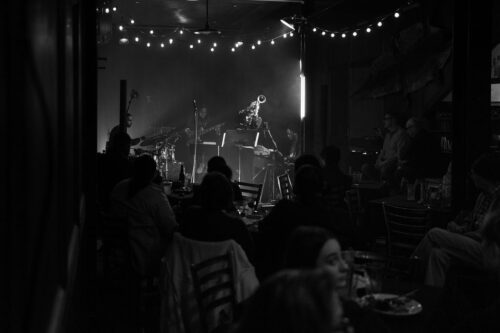
The Sonic Lifeline has been able to present a slew of top jazz talent at the Hemingway Room, including a sold-out show from the Dorseys — saxophonists Ebban and Ephriam — an up-and-coming sibling duo that represents “the next wave of Baltimore jazz,” Moreland said.
At the Hemingway Room, the Sonic Lifeline has built “a safe space for young artists to feel free,” Ephraim Dorsey told CapitalBop. “The scene and vibe they set is very comfortable and professional,” Ebban added.
Though the series is young, the Hemingway Room already has some national notariety; acclaimed drummer Anderson .Paak even sat in last year during a performance by powerhouse D.C. saxophonist Elijah Easton.
The Sonic Lifeline’s other series is held in partnership with Treehouse, a community organization on 14th Street NW that hosts arts events with the stated goal of being in service to the neighborhood. Treehouse initially tapped the Sonic Lifeline to help curate an Art All Night show in 2023. As Treehouse is an organization focused on providing a community arts space, they found a “very natural partnership” with the Sonic Lifeline, according to Qaree Dreher, one of Treehouse’s core team members.
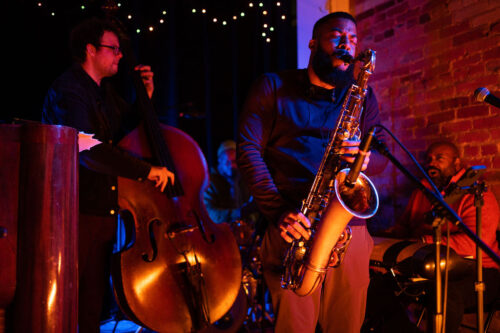
Jazz has been experiencing a resurgence of its audience across the United States, and Dreher feels that the Sonic Lifeline have their hands on the pulse of what jazz sounds like on the East Coast today — and where it’s going. The Sonic Lifeline is the “end-to-end conduit for jazz in the D.C. area,” he said. Working together with their network of friends and artists, Moreland and Baldi not only identify great talent, but also provide marketing, professional lighting, set design and professional-grade photography (the last one courtesy of Moreland). The lighting is especially notable for Dreher, who pointed out how ideal it is for artists of color in particular. “Every single detail is so intentional, and it brings the best out of the artists,” Dreher said.
Moreland recalled the energy of the live music scene on U Street from his youth, back in the 2000s and early 2010s. Live music isn’t “as prevalent in that area of the city as much now as it was 10 to 15 years ago when I was in my 20s going down there,” he said. The Sonic Lifeline is helping to keep that energy flowing on U Street, while also introducing the music to different parts of the city. No matter where they are, these shows’ focus is always on presenting something musically fresh.
The Sonic Lifeline’s events create a space, Baldi said, that “wasn’t there the day before, and won’t be there the day after.”
The Jam Sessions at Whitlow’s DC are held on Tuesday nights from 9:30 p.m. to 12:00 a.m. To find out about the Sonic Lifeline’s other shows, including its Hemingway Room series and Treehouse events, follow its Eventbrite page.

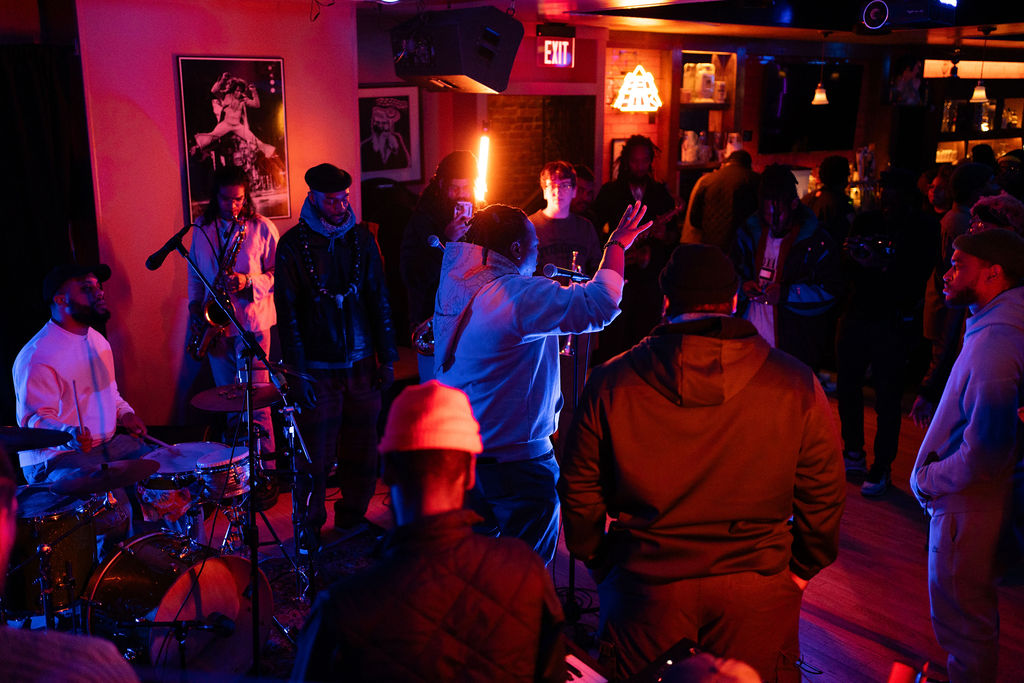






Join the Conversation →